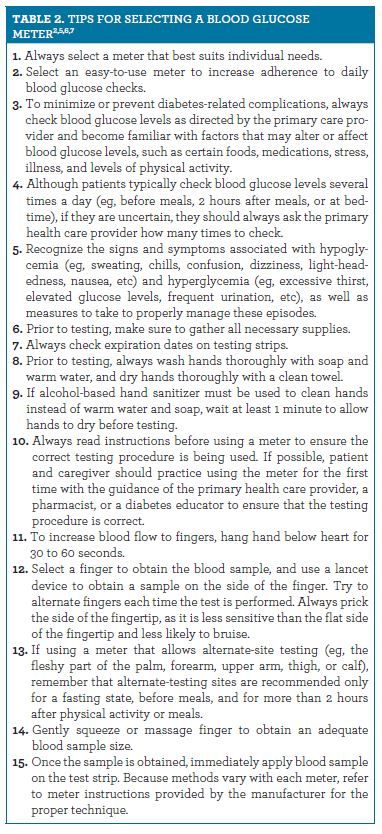Publication
Article
Pharmacy Times
Self-Monitoring of Blood Glucose: An Essential Weapon in Managing Diabetes
Author(s):
The number of diabetes cases continues to soar, with the latest data showing that an estimated 30.3 million Americans have the disease.
The number of diabetes cases continues to soar, with the latest data showing that an estimated 30.3 million Americans have the disease. More than 7.2 million of those individuals are unaware that they have diabetes, while countless others are at risk for the disease.1
Having a reliable and easy-to-use blood glucose meter is an indispensable and powerful tool that all patients with diabetes can use throughout the day to keep track of blood glucose patterns and daily targets, prevent or detect episodes of hyperglycemia or hypoglycemia, and monitor their glycemic response to certain foods, medications, physical activity, and therapy changes.2 Results from a plethora of clinical studies have validated the critical nature of maintaining tight glycemic control to effectively manage diabetes, as well as reduce or prevent the various health-related complications associated with poorly controlled diabetes. Results from a recent study show that continuous glucose monitoring (CGM) may benefit adults with type 2 diabetes who use multiple daily insulin injections, and the patients in the study showed improved glycemic control.3 CGM is approved for use by adults and children via a prescription and is typically used in patients who have type 1 diabetes but can also be used in those who have type 2 diabetes. Patients should discuss this issue with their primary health care provider to determine whether they are suited for CGM.3 Routine self-monitoring of blood glucose remains the most effective tool to monitor and provide critical information to manage diabetes (Table 1).

Selecting a blood glucose meter may be an overwhelming task for many patients with diabetes, especially those who have recently received a diagnosis. Pharmacists are in a pivotal position to guide patients in the proper selection and use of these types of meters (Table 22,5,6,7).

There are a host of self-testing blood glucose meters to suit the needs of all patients, even children (Table 37). Technological advances allow manufacturers to make blood glucose meters that are less invasive and less painful when testing, require a smaller sample size, are capable of alternate-site testing, and provide rapid testing results and the ability to test without interrupting an individual’s daily routine.2 Moreover, many blood glucose meters on the market have large memory storage; some have audio capability, while others can measure blood pressure or ketones in addition to blood glucose levels. Some meters plug into smartphones to display results. Advances in technology are providing patients with diabetes innovative features to help them monitor blood glucose levels to effectively manage their diabetes.
Table 3. Examples of Blood Glucose Meters7
Abbott Diabetes Care (myfreestyle.com)
- FreeStyle Lite
- FreeStyle Freedom Lite
- FreeStyle InsuLinx
- FreeStyle Precision Neo
AgaMatrix, Inc (agamatrix.com)
- Jazz Wireless 2
- WaveSense Presto Pro
- WaveSense Presto
Arkray USA (arkrayusa.com)
- Glucocard Expression
- Glucocard 01
- Glucocard Shine
- Glucocard Vital
Ascensia Diabetes Care (contournext.com)
- Contour
- Contour Next
- Contour Next EZ
- Contour Next Link
- Contour Next Link 2.4
- Contour Next One
CVS (cvs.com)
- CVS Advanced Blood Glucose Meter
- CVS Blood Glucose Monitor, Featuring TrueTrack Smart System
- CVS True Metrix Air Self-Monitoring Blood Glucose Meter
- CVS True Metrix Go Meter Kit
- CVS True Metrix Self-Monitoring Blood Glucose Meter
Dario Health (mydario.com)
- Dario All-in-One Smart Glucose Meter
Diabetic Supply of Suncoast (totaldiabetessupply.com/collections/advocate)
- Advocate Redi-Code, Plus Speaking Meter
Entra Health (entrahealth.com)
- MyGlucoHealth Wireless
- MyGlucoHealth Wireless Cellular
- BLE Smart Wireless System
Fifty 50 Medical (fifty50.com)
- Fifty 50 2.0
- Fifty 50 2.0 Sport
Fora Care (foracare.com)
- Fora D40D & D40G 2 in 1
- Fora GD50
- Fora Goldadvance Plus
- Fora Premium V10MD
- Fora MD
- Fora Premium V10 & For a Premium V10 BLS
- Fora V30
- Test N Go
- Test N Go Voice
Genesis (genesishealthtechnologies.com)
- GHT Blood Glucose Meter
IHealth Labs (ihealthlabs.com)
- Align
- Smart Gluco-Monitoring System
Lifescan (onetouch.com)
- OneTouch Ping
- OneTouch Ultra 2
- OneTouch Ultra Mini
- OneTouch Verio Blood Glucose Monitoring System
- OneTouch Verio
- OneTouch Verio IQ
Livongo Health (livongo.com)
- Livongo Meter
Nova Diabetes Care (novacares.com)
- Novo Max Plus
- Novo Max Link
Oak Tree Health (oaktree-health.com)
- EasyMax NG/LTC
- EasyMax Voice
- EasyMax Voice 2nd Generation
- FortisCare EM66
- FortisCare EMV3
- FortisCare MU
- FortisCare T1
Omnis Health (omnishealth.com)
- Embrace
- EmbracePRO
- EmbraceEVO
One Drop (onedrop.today)
- One Drop Chrome
Prodigy Diabetes Care (prodigymeter.com)
- Prodigy AutoCode
- Prodigy iConnect
- Prodigy Pocket
- Prodigy Voice
Roche Diagnostics (accu-chek.com/us)
- Accu-Chek Aviva
- Accu-Chek Aviva Connect
- Accu-Check Aviva Guide
- Accu-Chek Compact Plus
- Accu-Check Nano
Telcare (telcare.com)
- Telcare BGM
US Diagnostics (usdiagnostics.net)
- Control
- EasyGluco
- EasyGluco Plus
- Infinity
Wal-Mart Pharmacies (relion.com)
- ReliOn Prime
- ReliOn Micro
- ReliOn Confirm
- ReliOn Ultima
The first-of-its-kind application EPIC is undergoing clinical trials and should be released this year.4 It allows users to accurately measure their blood glucose levels noninvasively, without drawing a drop of blood. Instead, patients place their fingertip over the camera lens of a smartphone, and the app then takes a series of close-up images that can accurately show information about patients’ blood flow; these are sent up to the cloud for analysis and can then provide feedback on all kinds of vital signs, from heart rate, temperature, and blood pressure to respiration rate and blood oxygen saturation.4
Selecting a Blood Glucose Meter
Pharmacists are in a key position to aid patients in the proper selection and use of self-monitoring blood glucose meters. Factors and features that patients may consider when selecting a meter include 1 or more of the following2,5:
- Ease of use and an easy-to-follow testing procedure
- Accuracy of test results
- Types of batteries required
- Compact and lightweight meter
- Smaller blood sample sizes required for testing
- Capable of using alternating testing sites
- Rapid testing procedure and availability of results
- Ease of portability to allow testing virtually anywhere, including at school and work and during leisure time
- Easy-to-read numbers on display
- Memory options
- Affordable costs of meter and testing supplies
- Cleaning procedure
- High-tech features such as audio capability and wireless-transfer technology
- Features to accommodate patients with visual impairments or dexterity issues
After choosing a blood glucose meter, it is imperative that the patient is at ease using it and understands the steps to execute the proper testing procedure to obtain accurate and reliable results. It is also critical that pharmacists stress the magnitude of adhering to their recommended treatment plan, including medications, blood glucose monitoring regimens, a healthy and balanced diet, and exercise routines. Patients should also be encouraged to keep a record of their blood glucose readings and to always discuss these results with their primary health care provider during routine visits as well as contact their primary health care provider immediately if there are any concerns about blood glucose levels outside the target levels.
Conclusion
When counseling patients about at-home blood glucose meters, pharmacists can also take the opportunity to remind patients about the significance of daily blood glucose monitoring, compliance with therapy, and regular medical care to effectively control diabetes and prevent or reduce the incidence of diabetes-related complications. Patients should understand that self-monitoring of blood glucose should be an integral part of their daily routines to enhance outcomes and to decrease diabetic-related complications such as cardiovascular disease, neuropathy, retinopathy, foot issues, and skin conditions. A blood glucose meter is an essential weapon in the fight against diabetes, and pharmacists can be educators and advocates for all patients in the diabetes population.
Ms. Terrie is a clinical pharmacist and medical writer based in Haymarket, Virginia.







